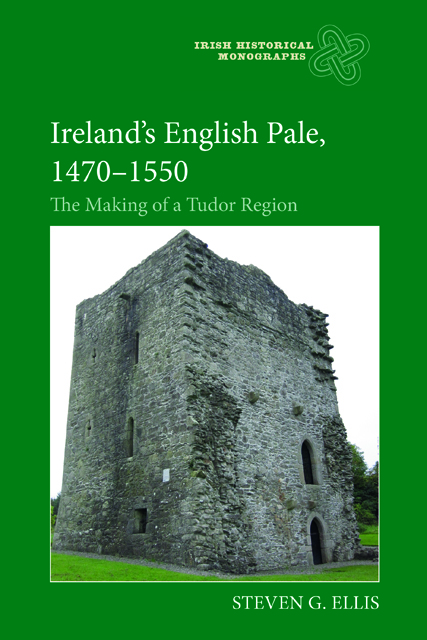Book contents
- Frontmatter
- Contents
- List of Maps
- Preface
- List of Abbreviations
- Introduction: in search of Ireland's English Pale
- 1 The horizons of English rule: retreat and recovery
- 2 The fortifications and identity of a military frontier
- 3 County Dublin and the military frontier
- 4 Strengthening the march in County Kildare
- 5 The English Pale's westward expansion: County Meath
- 6 The English Pale's northern frontier: County Louth
- 7 Restoring the English Pale, 1534-41
- 8 The waning of the English Pale
- Conclusion: an English region in Tudor Ireland
- Bibliography
- Index
- Irish Historical Monographs previous volumes
1 - The horizons of English rule: retreat and recovery
Published online by Cambridge University Press: 09 January 2024
- Frontmatter
- Contents
- List of Maps
- Preface
- List of Abbreviations
- Introduction: in search of Ireland's English Pale
- 1 The horizons of English rule: retreat and recovery
- 2 The fortifications and identity of a military frontier
- 3 County Dublin and the military frontier
- 4 Strengthening the march in County Kildare
- 5 The English Pale's westward expansion: County Meath
- 6 The English Pale's northern frontier: County Louth
- 7 Restoring the English Pale, 1534-41
- 8 The waning of the English Pale
- Conclusion: an English region in Tudor Ireland
- Bibliography
- Index
- Irish Historical Monographs previous volumes
Summary
In 1495, parliament ordered the building of ramparts and ditches to strengthen defences in ‘the marches of the iiii shires’, as the statute rather vaguely described them. Legislation applying only to the four shires had become more common of late, but the statute was also entitled ‘diches to be made aboute the Inglishe pale’, the first reference to the Dublin area as ‘the English Pale’. The reference encapsu¬lated the Pale’s dual meaning: it was both a spatial expression, the area previously described as ‘the four obedient shires’, and a border or frontier demarcating that area. This opening chapter considers how those parts of the medieval lordship ruled directly by the Dublin government, and known in the fifteenth century as ‘the four obedient shires’, eventually came to be seen as a distinct region called ‘the English Pale’. The next chapter will then discuss the Pale’s character as a military frontier.
The medieval boundaries of Dublin, Meath, Kildare, and Louth – the ‘four obedient shires’ in the fifteenth century – were vague in the extreme. Nominally, County Dublin stretched south to Wicklow town, including most of modern County Wicklow. South of Wicklow lay an exclave of Kildare, but most of medieval Kildare extended westwards from the modern county to include much of modern Counties Laois and Offaly. Medieval Meath included modern County Westmeath, stretching halfway across Ireland from the coast south of Drogheda to Athlone. Only Louth’s medieval boundaries approximated to those of the modern county. In 1515, however, only half of these four shires were ‘subjett unto the kings lawes’, as a Tudor reform treatise claimed. Their medieval boundaries had all been established before 1300, as the English lordship reached its greatest extent; but by 1460 the Gaelic revival had greatly reduced the effective area of English rule, before a limited recovery across the four shires had set in after 1470. This description was thus of marginal value in indicating how much of the four shires was actually under English rule: a more helpful description was ‘the English Pale’ which, as the 1495 statute implied, denoted the region in which English rule actually operated.
The English borderland established along the coastal plain between Dublin and Dundalk had originally developed as part of the medieval English lordship of Ireland.
- Type
- Chapter
- Information
- Ireland's English Pale, 1470-1550The Making of a Tudor Region, pp. 14 - 38Publisher: Boydell & BrewerPrint publication year: 2021



